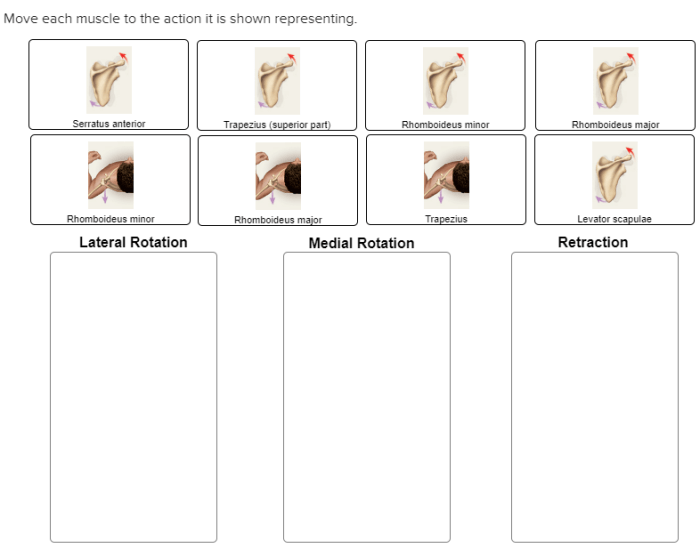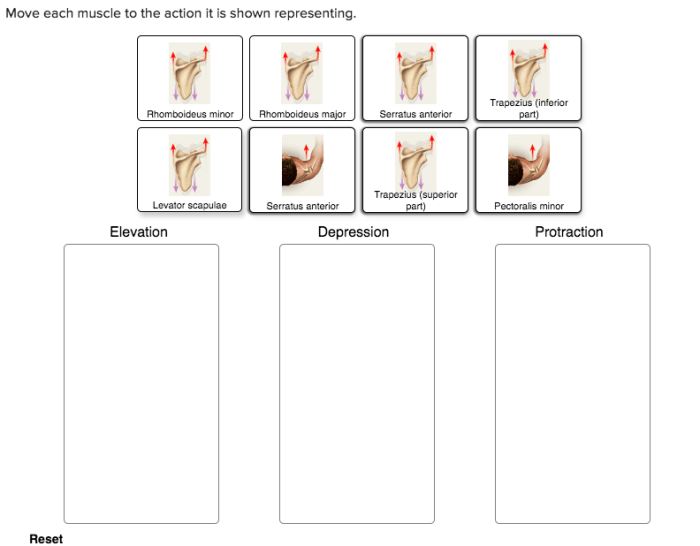Move each muscle to the action it is shown representing. Embark on a comprehensive journey into the intricate world of muscle movement, where each muscle performs a specific action, contributing to the symphony of human motion. From understanding the connection between muscles and actions to exploring the role of the nervous system in movement execution, this guide delves into the fascinating realm of muscle function.
Delve deeper into the types of muscle actions, categorized and explained with precision. Discover the significance of muscle movement for overall well-being, enhancing mobility, strength, and coordination. Moreover, witness the practical applications of muscle movement knowledge in exercise and rehabilitation, unlocking new possibilities for physical optimization.
1. Muscular System Representation: Move Each Muscle To The Action It Is Shown Representing.

The muscular system is a complex network of tissues that allows for movement and other bodily functions. Muscles are attached to bones and other structures, and when they contract, they pull on these structures, causing movement.
Each muscle is associated with a specific action or set of actions. For example, the biceps muscle in the upper arm is responsible for flexing the elbow, while the quadriceps muscle in the thigh is responsible for extending the knee.
2. Movement Execution, Move each muscle to the action it is shown representing.
When we move a muscle, the nervous system sends a signal to the muscle, causing it to contract. The contraction of the muscle pulls on the bone or other structure that it is attached to, causing movement.
The nervous system plays a key role in coordinating muscle movements. It sends signals to the muscles in the correct sequence and with the correct timing, allowing for smooth and efficient movement.
3. Types of Muscle Actions
There are several different types of muscle actions, each of which produces a different type of movement.
| Type of Action | Description | Example |
|---|---|---|
| Flexion | Bending a joint | Biceps muscle flexing the elbow |
| Extension | Straightening a joint | Triceps muscle extending the elbow |
| Abduction | Moving a limb away from the midline of the body | Deltoid muscle abducting the arm |
| Adduction | Moving a limb towards the midline of the body | Adductor muscle adducting the thigh |
4. Importance of Muscle Movement
Muscle movement is essential for overall health and well-being. It allows us to perform everyday activities, such as walking, running, and lifting objects.
Regular muscle movement also helps to maintain strength, mobility, and coordination. It can also help to reduce the risk of falls and other injuries.
5. Applications in Exercise and Rehabilitation
Understanding muscle movement can enhance exercise programs and aid in rehabilitation after injuries.
For example, knowing which muscles are responsible for specific movements can help you to design exercises that target those muscles.
Similarly, understanding muscle movement can help physical therapists to develop rehabilitation programs that help patients to regain lost mobility and function.
6. Additional Resources
For further exploration of muscle movement, the following resources are recommended:
- Human Anatomy and Physiology by Elaine Marieb and Katja Hoehn
- Kinesiology: The Mechanics and Pathomechanics of Human Movement by Joseph Hamill and Kathleen Knutzen
- The Muscle and Bone Palpation Manual with Trigger Points, Referral Patterns and Stretching by Joseph Muscolino and Thomas Moore
Common Queries
What is the primary function of muscles?
Muscles generate force and movement, enabling us to perform a wide range of actions, from walking and talking to lifting heavy objects.
How does the nervous system control muscle movement?
The nervous system sends signals to muscles, triggering them to contract or relax, resulting in movement.
What are the different types of muscle actions?
Muscle actions include flexion, extension, abduction, adduction, and rotation, each involving specific muscle groups.
Why is muscle movement important for overall health?
Muscle movement promotes mobility, strength, coordination, and metabolic health, contributing to overall well-being.
How is muscle movement knowledge applied in exercise and rehabilitation?
Understanding muscle movement optimizes exercise programs, enhancing performance and reducing the risk of injury. It also aids in rehabilitation, restoring muscle function after injuries.

